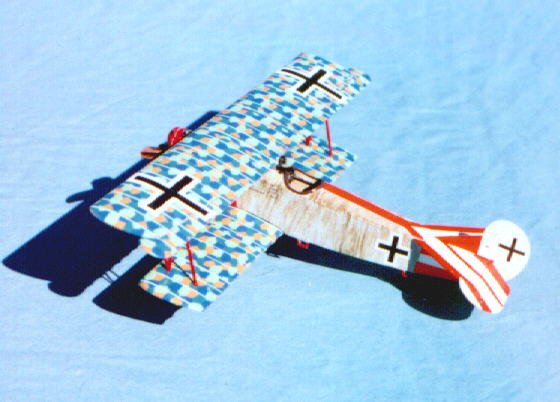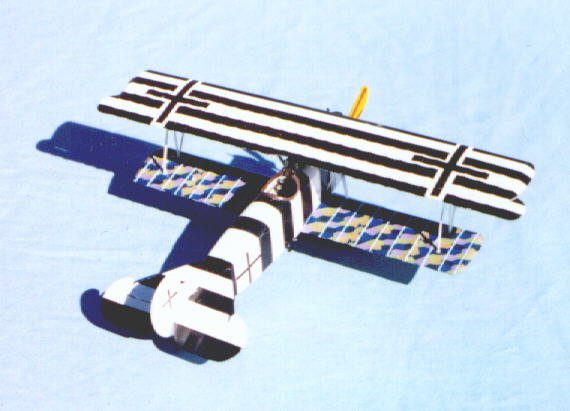Scale: 1/48
Manufacturer: Revellogram
Price: MSRP $10.00
Decals: Nothing to call home about
Accuracy: B+
Overall: A
Reviewed by: Thomas McKelvey Cleaver (THE AERONUT)

Every once in awhile, it's nice to be reminded that just because a kit isn't brand new doesn't mean it isn't pretty darned good. Monogram-Revell's Fokker D.VII, remastered 20-odd years ago from 40-year-old Aurora molds, is a good example of this fact.
I have a collector who wants every World War I airplane there is, so I am always on the lookout for possibilities (He pays well and regularly). Consequently, when two kits of the re-issued 1978-vintage Monogram Fokker D.VII showed up at the local shop, priced to sell, I picked them up. It helped that over in the decal drawer were an Aeromaster sheet for the D.VII, as well as the old standard Micro-Scale sheet from the late 70s, and a newer SuperScale sheet. Given that the decals that come with the kit are early-80s vintage, when Monogram was busy cost-cutting its way out of business, you can't even begin to consider doing this without those sheets, and some lozenge as well.
I had actually been looking for the kit because I received William Green's and Gordon Swanborough's "Fighting Colors" from Santa. The book is a compendium of the great color profiles that appeared in "Air International" and "Air Enthusiast Quarterly," back when these two excellent aviation historians (I think they might have even founded the subject) ran these magazines. There's a page on the D.VII that gives Bruno Loerzer's radically-marked D.VII. I'd also bookmarked a shot of a 1/72 model of Willy Gabriel's D.VII up at the World War I modelling site, filed under "might be good to try my own."
For those of you who aren't that familiar with the airplanes and personalities of World War I, the Fokker D.VII was the Me-262 of its era. Certainly it was as advanced over its contemporaries as the jet was over its opponents, with its cantilever wings and lack of bracing wires. Its handling characteristics were such that it was said the D.VII made the average pilot good, the good excellent and the excellent brilliant. It was a stable gun platform and could be held at a higher angle of attack before stalling than any other fighter of the war - leading some Allied opponents to claim it could "hang on its prop spitting bullets." It was specifically mentioned in the Treaty of Versailles that all D.VIIs were to be turned over to the Allies, the only German weapon used in the war to be so treated. Anthony Fokker shipped as many as he could lay hands on back home to Holland, laying the basis therewith for his postwar success. Among its pilots, Leutnants Bruno Loerzer and Willy Gabriel were among the better-known.
Loerzer was Hermann Goering's best friend, and second in command when Goering took over Jagdgeschwader 1 following the death of Manfred von Richtofen. Loerzer was never the committed Nazi Goering became, but he parlayed a lifelong friendship into high rank and office in the new Luftwaffe under his old CO and commanded air armies in the Polish and French campaigns and the Battle of Britain. The man was flamoyant in the extreme most of his life, and his black-and-white striped D.VII is certainly evidence of that.
Willy Gabriel was Loerzer's polar opposite. He flew two-seaters at the front for over two years before being transferred to Jasta 11 "Boelke" in Spring 1918 to become a fighter pilot. Gabriel scored 17 by June 1918, but his score was less important than his position as the only ace of Jagdgeschwader 1 permanently banned from returning to the front by his C.O., Hermann Goering. Old Hermann was a bombastic pain in the you-know-where a long time before the rest of the world noticed; he was the kind of man Gabriel couldn't stand, and the ace made no effort to hide his feelings, taking every opportunity he was presented to stick a pin in Goering's balloon. Gabriel also had the good fortune to live into his 90s; he was one of the very last First War German Aces still alive, and one of the few available for interviews when interest in the era revived 25 years ago - with that history, he was a natural for stories. So far as the modelling world is concerned, it helps that Renwal tried to do this airplane with its "Aeroskin" series, and that Cole Palen did his D.VII as Gabriel's airplane.
To me, the Monogram kit is still the best D.VII available. For one thing, the Dragon/DML isn't all that available, and even if it is newer and costs more, the result isn't as good. With the lower surface and fuselage fabric effect that Monogram did when they cleaned up the old Aurora molds, the airplane looks right when it's completed. The engine is more than acceptable, since you don't really see all that much of it, the struts are far more accurate and better-looking that DML's photoetch set, while detailing the spartan cockpit isn't that hard. There are those who say the upper wing isn't entirely accurate and that may be so - but it still looks better than the competition.
I know some very brave souls - good modellers every one - who are insane enough to mask and paint their own lozenge. Me, I'm quite happy to take the lozenge decals from Aeromaster and SuperScale, and roll on that printed fabric the way the originals did. With these two kits, I used lozenge sheets that were already in my decal box, so Gabriel's ended up with Ameromaster "green" 4-color lozenge because it is an earlier D.VII, and I would have to do the whole of both wings; Aeromaster gives you enough rib tape to do that. Loerzer's has the lower surface of the upper wing, the upper surface of the lower wing, and the upper surface of the airfoil spreader bar in lozenge. The amount of SuperScale Lozenge and rib tape I had was just enough.
Fortunately, all the decal manufacturers include application diagrams with their lozenge decals. In the case of the D.VII, the fabric is applied straight across the airfoil; for the lower wing, this was tip-to-tip, which requires you make an airfoil-shaped section for that fuselage cutout, as well as trim the fuselage so the wing will fit. Applying it is time-consuming, but if you do it right the result is terrific. I do the lower surface, let it dry completely (there's no such thing as too much decal solvent usage at this stage), then the upper. Once it's all dry and varnished again, I cut and apply the rib tape. Luckily, the Fokker's wing is a straight section, so one size for each wing fits all. I cut off the ailerons on my World War I models, and this is necessary when doing the D.VII inasmuch as the fabric is applied spanwise on the ailerons.
While the wings are drying, I go to work on the fuselage. It's easy to date Gabriel's airplane because of the early straight crosses and the fact it has the early Fokker fuselage, painted light blue and streaked with olive green on the upper surfaces. Loerzer's dates as a mid-production D.VII because of the timing of his receiving it. In both cases, this meant fuselages that were not done with lozenge fabric. When doing a D.VII that does have a lozenge fuselage, whether painted something else over the exterior fabric or not, you must remember to decal the INSIDE of the fuselage as well, before putting in the airframe and other interior bits and pieces. For these two, all I had to do was spray the interior fabric tan, then put in the airframe pieces. These are easily done, since the outside of the fuselage shows the fabric stretched over the airframe, which gives you the placement. For instruments, I use pieces of tree, cut about 1/8 inch long, as instrument cans. The Germans largely never got the hang of an instrument panel during World War I, and the placement of five instruments was idiosyncratic to each pilot. In other words, stick them anyplace that seems logical, is out of the way of the guns, throttle and stick, and you're likely okay.
With both airplanes, I used decals for the outer markings.
The Loerzer D.VII is painted white overall, with a black cowling and wheels, with the rest of the stripes done with decals. The upper stripes are 5/32" wide, the lowers are 1/8". The fuselage and horizontal stabilizer stripes are 5/16" wide. Again, it's a case of apply then wait for them to dry.
With the Gabriel D.VII, I painted the fuselage overall light blue, with a white rear section under the horizontal stabilizer and white for the horizontal and vertical surfaces, with a glossy red nose and struts. I used a 1/8" flat-tipped brush to dry-brush the streaky olive-green camouflage. I then used a sheet of orange decal color to do the rest of the tail section.
At this point, I had the wings done, fuselages and tails done, and all still in subassemblies, only the fuselage being complete. Assembly past that was easy, with the results you see above.
There are a lot of schemes you can do the D.VII in: early 4-color, late 5-color lozenge, and all kinds of colorful fuselages if you want to do German aircraft. There's post-war Dutch (olive green overall with orange disc insignia), there's U.S. Army Air Service (two fighter squadrons!) with OD fuselage and yellow wings and tail, and USMC aircraft for you golden wings types. You can have a lot of fun with this old kit, and you won't have to break yourpiggy bank to do so. To keep your budget down, I recommend getting the Squadron-Signal book if you don't have references.
